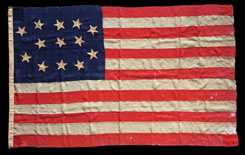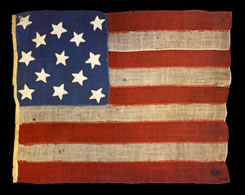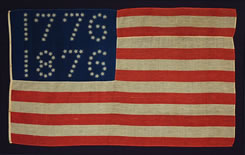Collecting flags is one of my passions but in doing a bit of research I found the world's largest dealer of early American Stars & Stripes...

Per Mr. Bridgman, "People are often surprised to learn that before 1912, lack of a specific design for the American national flag left a great deal open to interpretation and imagination. Given the level of respect our flag demands today, it is difficult to conceive that for the first 135 years of its existence, the star pattern was left up to the whims of its maker. The same was true of the number of points on the stars, not to mentions all aspects of the flag's proportions." (www.jeffbridgman.com)

"Because so many interesting star configurations were designed by individuals who lacked formal training, Stars & Stripes of the 18th, 19th and early 20th centuries can be viewed as some of the greatest creations in the history of American folk art. " (www.jeffbridgman.com)

"There are basically two types of flags: sewn flags and parade flags. 19th century sewn flags are typically larger than seven feet in length. They were pieced together by hand-stitching or by machine, and were intended for use over extended periods of time. Parade flags are typically small in size, generally less than three feet, and were printed on cotton, silk, wool, and sometimes paper. Also called hand-wavers, their purpose was intended for short term use at parades, political rallies, and other patriotic engagements. Parade flags were typically tacked or glued to a stick, intended to be waved at an event. Sewn flags were flown on staffs, poles, or masts, draped vertically on the walls of buildings, and hung from ropes, balconies or porches." (www.jeffbridgman.com)
Please visit Mr. Bridgman's web site and explore his painted furniture, folk art, antiques and textiles.
Many thanks to him for allowing use of his wonderful photos and info!
From your friends at PHM!



Very interesting article!!! Thank you for sharing all the info!
ReplyDelete